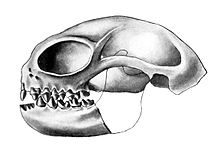Loading AI tools
Extinct family of primates From Wikipedia, the free encyclopedia
Omomyidae is a group of early primates that radiated during the Eocene epoch between about 55 to 34 million years ago (mya). Fossil omomyids are found in North America, Europe & Asia, making it one of two groups of Eocene primates with a geographic distribution spanning holarctic continents, the other being the adapids (family Adapidae). Early representatives of the Omomyidae and Adapidae appear suddenly at the beginning of the Eocene (56 mya) in North America, Europe, and Asia, and are the earliest known crown primates.
| Omomyidae | |
|---|---|
 | |
| The skull of Anaptomorphus | |
| Scientific classification | |
| Domain: | Eukaryota |
| Kingdom: | Animalia |
| Phylum: | Chordata |
| Class: | Mammalia |
| Order: | Primates |
| Suborder: | Haplorhini |
| Clade: | †Omomyiformes |
| Superfamily: | †Omomyoidea |
| Family: | †Omomyidae |
| Subgroups | |
| |
| Synonyms | |

Features that characterize many omomyids include large orbits (eye sockets), shortened rostra and dental arcades, loss of anterior premolars, cheek teeth adapted for insectivorous or frugivorous diets, and relatively small body mass (i.e., less than 500 g). However, by the late middle Eocene (about 40 mya), some North American omomyids evolved body masses in excess of 1 kg (2.2 lb) and frugivorous or folivorous diets. The largest omomyids were Macrotarsius and Ourayia, both at 1.5–2 kg (3.3–4.4 lb) in weight.[3] Large orbits in genera such as Tetonius, Shoshonius, Necrolemur, and Microchoerus indicate that these taxa were probably nocturnal. At least one omomyid genus from the late Eocene of Texas (Rooneyia) had small orbits and was probably diurnal.
Like primates alive today, omomyids had grasping hands and feet with digits tipped by nails instead of claws, although they possessed toilet claws like modern lemurs.[4] Features of their skeletons strongly indicate that omomyids lived in trees.[3] In at least one genus (Necrolemur), the lower leg bones, the tibia and fibula, were fused as in modern tarsiers. This feature may indicate that Necrolemur leaped frequently. Most other omomyid genera (e.g., Omomys) lack specializations for leaping, and their skeletons are more like those of living dwarf and mouse lemurs.
Omomyid systematics and evolutionary relationships are controversial. Authors have suggested that omomyids are either:
Recent research suggests the Omomyiformes are stem haplorhines, making them likely a paraphyletic grouping.[7]
Attempts to link omomyids to living groups have been complicated by their primitive (plesiomorphic) skeletal anatomy. For example, omomyids lack the numerous skeletal specializations of living haplorhines. These haplorhine adaptations - absent in omomyids - include:
Omomyids further demonstrate a gap between the upper central incisors, which presumably indicates the presence of a rhinarium and philtrum to channel fluids into the vomeronasal organ. Omomyids as a group also lack most of the derived specializations of living tarsiers, such as extremely enlarged orbits (Shoshonius is a possible exception), a large supra-meatal foramen for an anastomosis between the posterior auricular and middle meningeal circulation (again, Shoshonius is a possible exception, but the contents of the foramen in this extinct taxon are unknown), and extreme postcranial adaptations for leaping.
Among primates, omomyids have a uniquely derived characteristic. This is the presence of an aphaneric (not visible or readily distinguishable, due to its position), or "intrabullar" (within the bullae), ectotympanic bone, connected to the lateral wall of the auditory bulla by an unbroken annular bridge.
This section needs additional citations for verification. (December 2023) |
Seamless Wikipedia browsing. On steroids.
Every time you click a link to Wikipedia, Wiktionary or Wikiquote in your browser's search results, it will show the modern Wikiwand interface.
Wikiwand extension is a five stars, simple, with minimum permission required to keep your browsing private, safe and transparent.